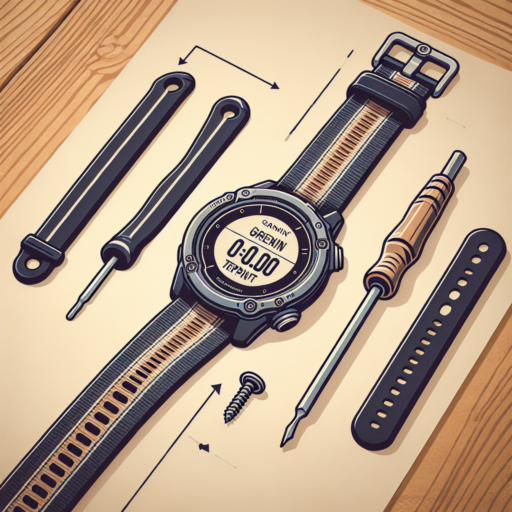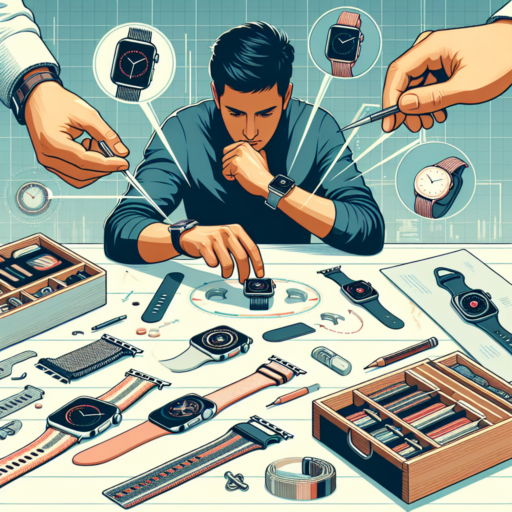Ultimate Guide to Easily Remove Your Watch Strap
Changing or removing a watch strap might seem daunting at first, especially if you’re doing it for the first time. However, with the right tools and techniques, the process can be straightforward and hassle-free. Whether you’re looking to replace an old strap, clean your watch, or simply want to switch up your style, this guide will assist you in removing your watch strap easily and safely.
Tools You’ll Need
Before you start, ensure you have the necessary tools. A small flat-head screwdriver or a spring bar tool is essential for most watch types. It’s also beneficial to have a soft cloth or mat to place your watch on during the process to prevent scratches. For watches with a quick release mechanism, these specialized tools might not be necessary, but handling your watch carefully is still crucial.
Step-by-Step Guide to Removing Your Watch Strap
- Prepare Your Workspace: Lay your watch on a soft cloth or mat to protect it. Ensure your workspace is well-lit and that you have ample room to work.
- Locate the Spring Bars: Identify the small pegs or bars that hold your strap in place. These are usually located on the underside of the watch, at the end of the strap.
- Use Your Tool: Carefully insert the forked end of your spring bar tool or the edge of your screwdriver between the strap and the watch lug. Gently apply pressure to compress the spring bar, then carefully remove the strap from the lug.
For many, the fear of damaging their precious timepiece during the strap removal process is genuine. However, by following these simple steps and proceeding with gentle precision, you can remove your watch strap without causing any harm to your watch. Remember, patience and the right tools are key to a successful strap removal.
Step-by-Step Instructions on How to Remove Different Types of Watch Straps
Removing a watch strap can be a simple procedure, but it’s important to follow the correct steps to avoid damaging your watch. Whether you’re looking to swap out your strap for a new look or for maintenance, understanding the type of strap and the tools you might need is crucial. Below, we delve into the nuances of removing various types of watch straps.
Removing Leather and Fabric Straps
Leather and fabric straps are often attached with spring bars. To remove these:
- Position your watch face down on a soft surface to prevent scratches.
- Use a spring bar tool or a small flathead screwdriver to gently push against the spring bar’s end until it compresses.
- Carefully remove the spring bar from the lug, and the strap should release.
Remember, patience and gentle pressure are key to avoiding damage to your watch or the strap.
Removing Metal Bracelets
Metal bracelets may seem daunting due to their complex construction, but they’re not difficult to remove with the right approach. Follow these steps:
- Identify the link pins or screws that hold the bracelet together. These are typically located on the sides of the bracelet links.
- Using a small screwdriver or a pin removal tool, carefully remove the pins or screws.
- Once the connecting pin or screw is removed, the bracelet should separate from the watch case.
Ensure you keep all removed parts in a safe place to avoid loss and for easy reassembly.
Removing Silicone and Rubber Straps
Silicone and rubber straps are popular for their durability and comfort. Just like leather straps, they are usually attached with spring bars. To remove them:
- Secure your watch face down on a non-abrasive cloth to protect the screen.
- Use a spring bar tool to compress the spring bar and gently pull the strap away from the lug.
- If the strap does not release easily, ensure you are compressing the spring bar sufficiently before attempting to remove it again.
While flexibility makes these straps easier to handle, ensure you don’t stretch them excessively during removal.
No se han encontrado productos.
Tools You Need to Safely Remove Your Watch Strap
Removing your watch strap, whether for cleaning, repair, or replacement, requires a careful approach to ensure you don’t damage your watch or the strap itself. Having the right tools at your disposal can make this task smoother and safeguard the longevity of your timepiece. In this overview, we’ll explore essential tools that should be part of your toolkit for safely removing your watch strap.
Spring Bar Tool
The spring bar tool is indispensable for dealing with the spring bars that hold most watch straps in place. This tool typically comes with a forked tip that is perfect for compressing the spring bar and releasing the strap without scratching the watch case. Some models also feature a pointed tip on the opposite end, useful for watches with drilled lugs.
Case Back Opener
If your watch requires that you remove the back case to access the strap attachments, a case back opener is essential. There are different types of case back openers, so it’s important to use one that matches your watch’s case back design—whether it’s a snap-off, screw-off, or a case with notches.
- Watchmakers Loupe – For a closer inspection of the strap attachment area, ensuring you don’t miss any small details.
- Jeweler’s Screwdriver – Ideal for watches that use screws instead of spring bars to secure the strap.
- Tweezers – Handy for manipulating small parts without touching them directly, minimizing the risk of scratches or contamination.
Common Mistakes to Avoid When Removing Your Watch Strap
Changing your watch strap can completely revamp your watch’s look, but it’s a delicate process that requires careful attention to avoid common pitfalls. Many watch enthusiasts, eager to switch up their style, dive into the strap removal process without fully understanding the potential for damaging their beloved timepiece.
One frequent mistake is not using the correct tools. For a seamless removal, specific tools designed for your type of watch are necessary. Yet, many attempt this task with makeshift items like knives or screwdrivers, which can easily slip and scratch the watch casing or the strap itself. It’s crucial to invest in a proper watch tool kit to protect your investment.
Another error often made is applying too much force. It’s easy to underestimate the intricacy of watches, especially when faced with a strap that seems stubborn. Exerting excessive pressure can not only damage the strap but also interfere with the watch’s internal mechanism. The key is to apply gentle, steady force, ensuring you’re pulling or pushing in the correct direction as per the manufacturer’s instructions.
Tips for Removing a Leather Strap Without Damaging It
Removing a leather strap, whether from a watch, a bag, or any accessory, requires a delicate approach to maintain its integrity. Leather, being a naturally durable yet flexible material, can suffer from wear, tear, and damage if not handled properly. Utilizing the right technique and tools is paramount in ensuring that the strap remains unscathed during the removal process. Following these tips will help in preserving the quality and appearance of your leather strap.
Use the Correct Tools
One of the most crucial aspects in removing a leather strap safely is employing the right tools for the job. Opt for a spring bar tool if you’re detaching a watch strap, as it is specifically designed to maneuver the tiny mechanisms without scratching or tearing the leather. For other types of attachments, a small, flat-head screwdriver might suffice, but ensure it is covered with tape to prevent any accidental cuts or marks on the leather. Proceed gently and patiently to avoid any unnecessary damage.
Clean and Prep the Strap
Before attempting to remove the strap, it’s vital to clean and prepare it adequately. Use a soft, dry cloth to remove any surface dirt or grime that could potentially cause scratches during the removal process. If the leather is particularly stiff or dry, applying a small amount of leather conditioner can improve its flexibility, making the strap easier to handle and less prone to cracking. Remember, always test the conditioner on a small, inconspicuous area first to ensure it doesn’t alter the leather’s color or texture.
Maintain Proper Technique
Maintaining a proper technique throughout the removal process can greatly reduce the risk of damaging the leather. Always pull the strap away gently in a straight line, avoiding any twisting or bending motions that could stress and crack the leather. If resistance is met, assess the situation and apply additional tools if necessary, but never force the strap as it could lead to irreversible damage. It’s better to take your time and proceed with caution than to rush and risk harming the leather strap.
How to Remove a Metal Bracelet from Your Watch
Removing a metal bracelet from your watch can seem daunting at first, but with the right tools and a bit of patience, it can be a straightforward task. It’s essential to approach this process carefully to avoid damaging your watch. Whether you’re looking to replace an old bracelet, clean your watch, or change its style, the following steps will guide you through the removal process efficiently.
Firstly, you will need to gather a few tools: a small screwdriver or a spring bar tool, and possibly a pair of tweezers. It’s crucial to work in a well-lit area and have a soft, clean surface to lay your watch on during the process. This will help prevent any accidental scratches or damage.
Identify the Type of Bracelet Attachment
Different watches use various methods to attach their bracelets. Most commonly, you’ll encounter spring bars, which are small metal bars that fit into the ends of the watch bracelet, securing it to the watch case. In some cases, watches might use screws that require a screwdriver for removal. Identifying the attachment method is key to selecting the appropriate tool and technique for the task.
Removing the Bracelet
For spring bar types, carefully insert the forked end of the spring bar tool between the bracelet and the watch case. Apply gentle pressure to compress the spring bar and carefully slide the bracelet away from the watch case. Repeat on the other side of the watch to fully detach the bracelet. If your watch uses screws, use the screwdriver to unscrew each side. Keep the screws in a safe place as they are tiny and easy to lose.
By following these steps and handling your watch with care, removing a metal bracelet can be done efficiently, allowing you to perform maintenance or update the look of your watch without the need for professional assistance. Throughout the process, patience and attentiveness are your best tools.
Cleaning Your Watch After Strap Removal: Best Practices
Certainly, here’s content focusing on the provided H2:
Removing the strap from your watch exposes the areas that are often most susceptible to buildup of dirt and sweat, particularly around the lugs and the case back. This makes it crucial to follow a systematic cleaning procedure to ensure your watch maintains its aesthetic appeal and functional integrity. The cleaning process not only rejuvenates your watch’s appearance but can also extend its lifespan by preventing corrosion and wear.
Essential Cleaning Tools
Before we dive into the best practices for cleaning your watch after strap removal, it’s important to gather the right tools. A soft, lint-free cloth, a soft-bristled toothbrush, and a mild cleaning solution are essentials. For metal bracelets and water-resistant cases, isopropyl alcohol can be beneficial for disinfection. However, ensure your watch’s water resistance level before applying any liquid directly.
Step-by-Step Guide to Cleaning
Begin by wiping the watch case with a dry, soft cloth to remove any loose dirt. Dip the cloth into a mild soapy water solution and wring it out to avoid excessive moisture. Gently clean the case, focusing on the lug area and the back of the watch. Use the soft-bristled toothbrush for detailed cleaning around the crevices but do so with gentle pressure to avoid scratches. After cleaning, always ensure the watch is thoroughly dried with a clean, dry cloth. For watches with water resistance, a final rinse under clean water can help remove soap residues before drying.
Remember, the frequency and method of cleaning your watch after strap removal significantly affect its longevity and performance. Regular cleaning not only maintains the aesthetic appeal but also ensures optimal functioning by preventing buildup that can interfere with the watch mechanism. While specific cleaning practices may vary depending on the watch model and material, these general guidelines should serve as a foundation for effective watch care.
Troubleshooting: Dealing with Stubborn or Stuck Watch Straps
Having a stubborn or stuck watch strap can be a frustrating ordeal, especially when you’re in a hurry or trying to preserve the aesthetic and integrity of your favorite timepiece. The challenge often lies not just in the removal but also in ensuring not to cause any damage to the watch or strap. Here, we explore some effective strategies and tools that can help you tackle this common issue.
Identifying the Problem Area is the first step towards a solution. Whether it’s a pin that won’t budge, a slider that’s stuck, or a clasp that refuses to open, pinpointing exactly what part of the strap isn’t cooperating can save you a lot of time and avoid unnecessary damage. Sometimes, the issue can be as simple as accumulated dirt or corrosion, and identifying this can significantly simplify the troubleshooting process.
Using the Right Tools is crucial when dealing with stubborn or stuck watch straps. Tools like spring bar tools, watch pin removal tools, or a small precision screwdriver set can be invaluable. It’s important, however, to use these tools with care, applying pressure gradually to prevent damaging the watch or strap. For those without access to specific watch repair tools, using small household items like toothpicks or paper clips can sometimes offer a makeshift solution.
When to Seek Professional Help
While many stuck watch strap issues can be resolved with patience and the right approach, there are instances where it might be best to consult with a professional. Severe cases, where the risk of damaging the watch or strap is high, should be handled by experienced watch repair technicians. This not only ensures the safety of your timepiece but also can potentially save you from costly repairs or replacements down the line.
DIY vs. Professional Help: When to Seek Help for Watch Strap Removal
Deciding between DIY (Do It Yourself) and seeking professional help for watch strap removal can often be a dilemma for watch owners. While many may consider removing a watch strap a simple task, the reality is that without the right tools or knowledge, you could potentially damage your watch. Making the right choice depends on several factors including the type of watch, the complexity of the mechanism, and your personal experience with such tasks.
For enthusiasts who are comfortable with handling small tools and have experience with watches, DIY watch strap removal can be a satisfying task. This process requires attention to detail to avoid scratching the watch or strap. However, it’s crucial to understand that not all watch straps are created equally. Simple leather or metal bands might be easy to handle, but more complex mechanisms like those found in luxury or high-tech watches can present a significant challenge.
On the other hand, seeking professional help becomes imperative when dealing with high-value or intricate watches. Professionals have the necessary tools and expertise to remove and replace straps without causing harm to the watch. Additionally, if the watch is under warranty, attempting a DIY strap removal could void the warranty, making a professional service the safer choice. Whether you’re dealing with a stubborn pin, a concealed clasp, or simply don’t feel confident in undertaking the task, turning to a specialist can ensure that your timepiece remains in pristine condition.




